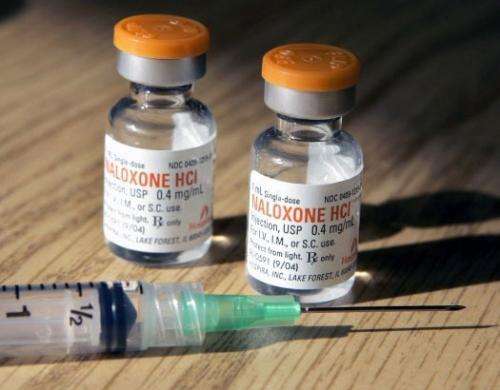Study shows naloxone kits cost-effective in preventing overdose deaths

(Medical Xpress)—Giving heroin users kits with the overdose antidote naloxone is a cost-effective way to prevent overdose deaths and save lives, according to a study released this week in The Annals of Internal Medicine.
Dr. Phillip Coffin, director of Substance Use Research at the San Francisco Department of Public Health and assistant clinical professor at the University of California San Francisco, and Sean Sullivan, professor and director of the Pharmaceutical Outcomes Research and Policy Program at the University of Washington in Seattle, co-authored the study
Drug overdose is now the leading cause of injury death in the United States. Opioids, such as heroin, account for about 80 percent of those deaths. Naloxone is a safe and effective antidote that works by temporarily blocking opioid receptors. As of 2010, 183 public health programs around the country, including those supported by the San Francisco Department of Public Health, had trained more than 53,000 individuals in how to use naloxone. These programs had documented more than 10,000 cases of successful overdose reversals.
The authors of this study developed a mathematical model to estimate the impact of distributing naloxone in this way. Their model was based on conservative estimates of the number of overdoses that occur each year. It accounted for people who overdose repeatedly. It also acknowledged that most people who overdose will survive whether or not they get naloxone.
In their basic model, Coffin and Sullivan estimated that reaching 20 percent of a million heroin users with naloxone would prevent about 9,000 overdose deaths over their lifetime. One life would be saved for every 164 naloxone kits given out. Based on more optimistic assumptions, naloxone could prevent as many as 43,000 deaths – one life for every 36 kits given out.
Naloxone distribution would cost about $400 for every quality-adjusted year of life gained. This value is well below the customary $50,000 cutoff for medical interventions. It is also cheaper than most well-accepted prevention programs in medicine and is most similar to the cost-effectiveness of smoking cessation or checking blood pressure. All reasonable assumptions produced costs that were well within traditional guidelines for cost-effectiveness.
"Naloxone is a highly cost-effective way to prevent overdose deaths," said Coffin. "And, as a researcher at the Department of Public Health, my priority is maximizing our resources to help improve the health of the community."
Naloxone has been distributed in San Francisco since the late 1990s and with San Francisco Department of Public Health support since 2004. During that time, heroin overdose fatalities slowly decreased from a peak of 155 in 1995 to 10 in 2010. Opioid analgesic deaths (such as those from the prescription pain medications oxycodone, methadone, or hydrocodone) remain elevated, with 121 deaths in 2010. Efforts are under way to expand access to naloxone for patients receiving prescription opioids as well.

















